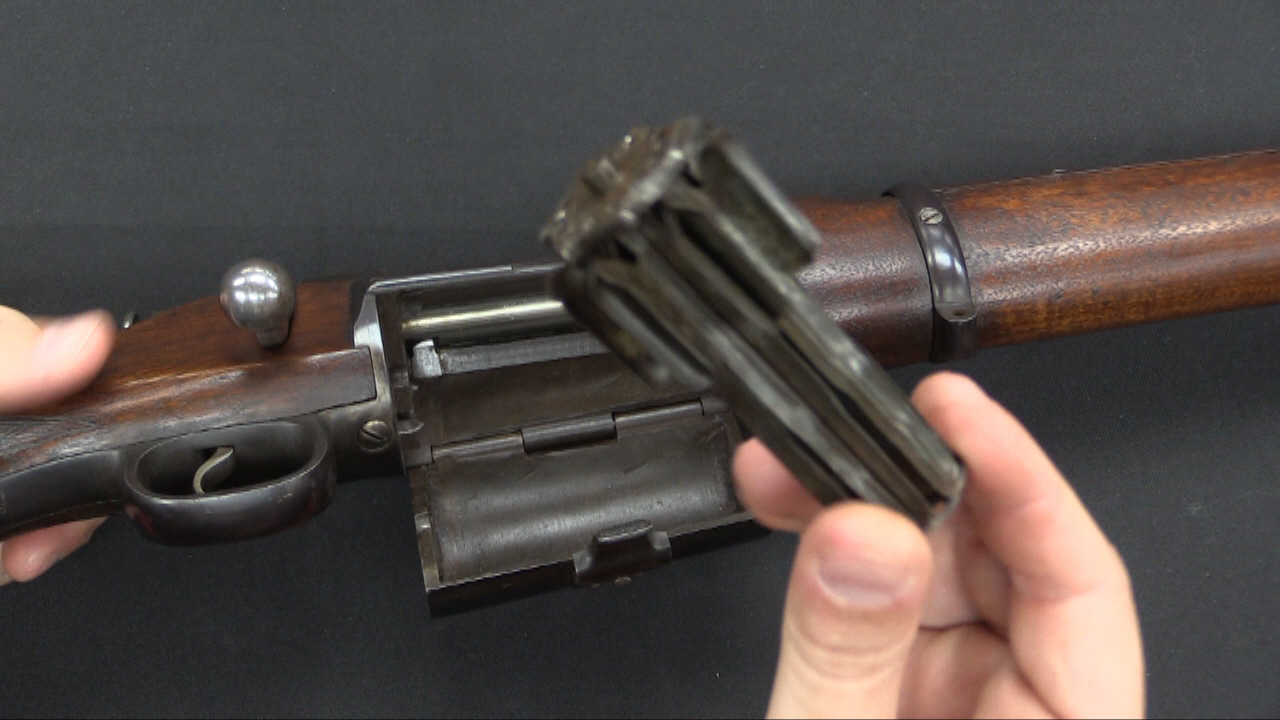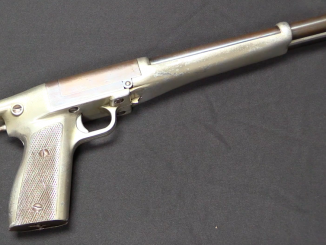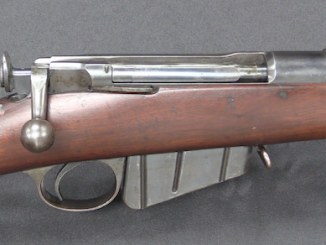At the turn of the 20th Century, prior to World War I, there were actually three semiauto sporting rifles on the market in the US. The two commonly known ones are the Winchester Model 5/7/10 and the Remington Model 8 – much less recognized is the Standard Arms Model G. It was a rifle that could be used in either semiauto or pump action mode, and it was also sold in a pump-only variant as the Model M. While this variant sidestepped the most significant parts breakage issues that plagued the Model G, it was a poor competitor to the Remington Model 14 pump action rifle and failed to sell well enough to save Standard Arms from a quick bankruptcy.
Related Articles

Bolt Action Rifles
Blake Bolt Action Rifle at RIA
The Blake was one of many rifle designs submitted to the US Army trials that would ultimately result in the adoption of the Krag-Jorgensen as the US Army’s standard rifle. The main innovation of Blake’s […]

Shotgun
California Arms Co 20ga “Defiance” Pistol-Shotgun
This registered NFA AOW sold for $3,738 at Rock Island on December 1, 2018. Made to compete with guns like the Ithaca Auto & Burglar, the “Defiance” form the California Arms Company is a side […]

Bolt Action Rifles
Remington-Lee Model 1899: A Final Smokeless Version
This is Lot #1230 in the upcoming December 2020 RIA Premier auction. The Model 1899 was the last pattern of the Remington Lee Military Rifle, following the models of 1879, 1882, and 1885. In this final […]

The Standard’s locking system resembles those later used on several types of pump-action shotguns, notably the Remington 870. It also somewhat resembles the lockup of the BAR, except that it has a one-piece bolt rather than an independent locking piece attached to the bolt.
The button under the pump forearm works a lot like that on the much later Franchi SPAS-12 shotgun. In fact, the Model G was apparently operated a lot like the SPAS-12.
The magazine works a lot like the one on the Russian Mosin-Nagant M1891 bolt-action rifle. The main difference being the magazine spring.
One question; What is that forearm “pump” made of, and how? Is it a stamping, or a casting, and is it brass, or bronze, or plated sheet steel, or what?
cheers
eon
“or what”
http://www.gundigest.com/gun-collecting-firearm-collecting/remembering-the-late-model-g
states that: “Cast of brass alloy”
Is metal good material for forearm? Most fire-arms has wooden or polymer forearms as it isolate heat.
Notice that Standard Arms Model G has also butt-plate matching forearm.
Thanks for the explanation. They may have chosen the brass casting for aesthetic reasons. Sort of like carving hunting scenes on the receiver.
Another possibility is strength. A cast-brass “pump” could be expected to stand up to heavier stress when stroked vigorously (say, by a hunter trying to get off a second shot at a high-balling buck) than a wooden one. Also, it would be easier to mount that pushbutton latch setup in a metal casting than a wooden piece, which would require a metal insert.
The major problems I can see are that the brass would reflect light, thus giving away the hunter’s presence to a typical paranoid buck. The second one is that in cold weather, if you weren’t wearing gloves you could lose some skin if your hand froze to it.
On the whole, a wooden forearm like the Remington Model 14’s, maybe with a brass or steel liner, would probably have been a better idea.
cheers
eon
“A cast-brass “pump” could be expected to stand up to heavier stress when stroked vigorously (say, by a hunter trying to get off a second shot at a high-balling buck) than a wooden one.”
Wooden forearm seems to be strong enough. Variant of Remington Model 14 – Remington Model 141 was produced until 1950 and all have wooden forearm, I am not aware of complaint about Model 141 forearm strength. Also notice that all US Army used many shotgun (called “trench gun”) with wooden forearms – if they will not be strong enough US Army would have ordered version with forearm from other materials. Examples of “trench gun” used by US Army with wooden forearm:
Ithaca Model 37 Trench Gun
Winchester Model 1912 Trench Gun
Stevens Model 620 Trench Gun
Do you know any other pump-action gun model with metal forearm (“pump”)?
I’ve never heard of one. It’s one of the things that makes the Standard such an unusual item.
cheers
eon
While this is a better gun than the Model G, I think it is still too complex and flashy to compete with other designs… No wonder it was a big flop.
Weapon of choice questionnaire:
In an outlandish scenario where you and your friends found yourselves in the trenches of some nasty static war against some early 20th century version of a “typical fantasy role-playing-game’s evil empire,” monsters, walking tanks, zeppelins and all, which would you grab from a friendly armory if all the best toys were already taken?
1. Standard Arms Model G or Model M
2. RSC 1918
3. Mondragon Semi-automatic rifle with drum magazine
4. Scotti Model X or Breda PG
5. Type 99 LMG with scope
6. Maxim QF Pom-Pom
7. FK 16 nA
8. Krupp K5 railway guns
9. Fiat M11/39 tanks
10. VK 4501 (P) heavy tank (Porsche’s failed Tiger Tank Prototypes)
11. Get a wing of Caproni Ca.335 fighter bombers and blow up the enemy airship hangars.
12. Screw the limitations and add your favorite toys to this list!
Go get your toys! KILL EVERYONE IN YOUR WAY!!!
Disclaimer: The questionnaire is for entertainment purposes only. You may ignore it if you wish.
Thanks for reading,
Cherndog
I’m already far away in my spaceship.
The planet destruction is only a question of minutes.
The trouble with trench warfare is also its advantage. Everything is pretty much fixed in position. So pre-registered fire plus fixed-position support generally gets the job done.
Artillery (including mortars for local “need-it-right-now” support)plus water-cooled heavy machine guns pretty much rule the battlefield. Tanks, if properly used with combined arms tactics, can break trench-line static front deadlocks, but if the ground ahead of them isn’t properly scouted so they can avoid AT guns, mine belts, and etc., they’re going to get murdered.
Armored cars aren’t even worth considering. They’re open-country vehicles, useful in a rapid “blitzkrieg” or for “policing” duties, but in a static trench-front scenario, they’re meat on the table for anyone with a heavy weapon (anything from a few Mills Bombs wired together on up).
The book I referenced on the “Astra clone” thread goes into great detail on all of this. Here’s the link again if you’re interested;
http://www.e-reading.club/bookreader.php/135797/Machine_Guns._An_Illustrated_History_of_Their_Impact.pdf
There is no one, perfect weapon, period. Least of all in trench warfare. But considering that the Iran-Iraq War of the 1980s ended up looking a lot like Flanders or Petersburg, it’s something we still need to be familiar with.
cheers
eon
The trench warfare never was fought on scale bigger than during WW1 (the Battle of Verdun lasts about 10 month, this is probably longest battle ever fought, excluding sieges) but it occurs from time of time (see for example Battle of Hill 180 (1951) during Korean War).
http://en.wikipedia.org/wiki/Trench_warfare states that current War in Eastern Ukraine feature trench warfare.
“Artillery”
Also the Great War was heyday of great caliber artillery also called super-heavy artillery like German Dicke Bertha (420mm), Austrian 42cm Autohaubitze, French Obusièr de 520 modele 1916 (railway gun)
And for “12. Screw the limitations and add your favorite toys to this list!”
Limiting choice for 1-man portable weapons: M18 recoilless rifle (57mm) seems to be handy “pocket artillery”. If portability is not issues, there are many weapons to chose.
very interesting g gun i must say,quick question i have a side by side hammer double barrel shotgun “greenway,,,bermingham self locking ,vertical grip under the barrel there is a few stamps but as well, 813
is it a british gun?
thanks for your reply , cheers marc